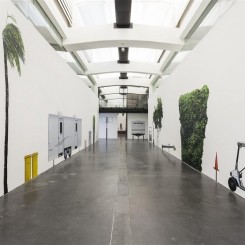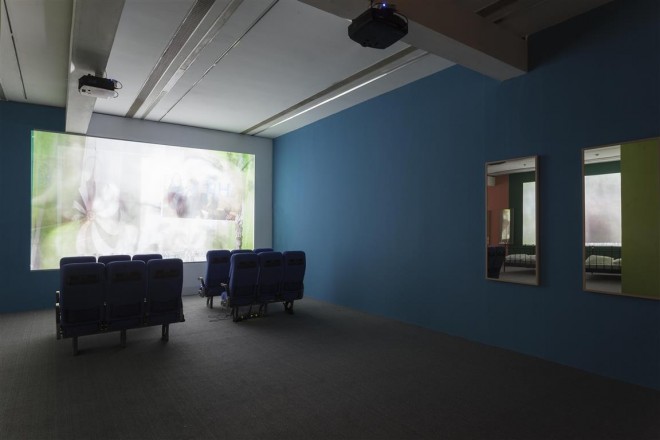UCCA (798 Art District, No. 4 Juxianqiao Lu, Chaoyang District, Bejing 100015), Sept 13 – Nov 9, 2014
The “Los Angeles Project” is not a thematic exhibition, and rightly so. Their shared origin naturally assumes prominence for one’s looking at these seven solo displays. But while “identity” has often proved a troubling word for contemporary art (not least in China)—conjuring inflated or personal questions that cannot be answered clearly, and may even distract from the work itself—it is simpler (and more direct) to see what one might take from this exhibition in the way of pure sensation, rather than something more complicated. What impressions do these shows deliver, individually and collectively, of the creative inclinations with which LA-based artists are working?
The varied impacts of the exhibitions make for a strong experience—without doubt, these works are the product of a different environment. Following a sense of filmic surface conjured by Alex Israel and Kathryn Andrews in the first two rooms, one is plunged into an immersive zone of hyperactive dialogue and sound on a number of video screens by Ryan Trecartin; beds and airline seats in front of them encourage the viewer to sprawl out. Aaron Curry offers a kind of respite with an emptier space occupied by white sculptures daubed with neon orange and yellow—potently reminiscent of twentieth-century surrealist figuration at ease in their strangeness. From here, one could go directly into the room devoted to Matthew Monohan’s distinctly manual sculptures and charcoal drawings (the most “traditional” part of the exhibition), or into a large oblong site of shining urethane obelisks and diffused pigments amassed by Sterling Ruby. The feeling of productive collapse that rises here appears strained and refocused in the work of Kaari Upson. Here, distressed furnishings (carpets and mattresses) and silicon-moulded chairs register the pressure of human contact, both physical and mental, between people and on domestic materials.
The “Los Angeles Project” conveys certain sensations more strongly than others. The first is a sort of deliberate unfaithfulness—or flatness. Alex Israel marks the walls with impenetrable yet seductive mural paintings: isolated instances of palm trees, a director’s chair, a caravan and rubbish bins lined up on a white backdrop. The imagery is at once aesthetically present and attractive, and knowingly absent—just like the stage sets it mimics. As such, the work affects perception in a similar way to film, suspending disbelief even as it engages the eye. In the adjoining room, the comfort—and, one could say, the freedom—of the real is pushed back still further. Kitsch, cold cylindrical sculptures bearing prints of Bozo the Clown are flanked by enormous images of pink-stockinged legs spread down the walls (the seduction scene from The Graduate). Walking through this installation, the viewer might find themselves uncomfortable, thrown in with a repeating cartoon character and giant, overbearing fiction lifted from an erotic film scene. Both directed rather than made by Israel and Andrews themselves, these two shows dispose with art’s expected delight in authenticity. In turn, their effect seems less to encourage than to aggressively place the viewer in relation to their creative processes—keeping one outside, yet seeing, and thereby somewhat vulnerable. The ambience is impersonal, the experience merely received.
Without wishing to draw their work too close together, there are like tendencies to detect also in Aaron Curry and Matthew Monohan’s displays. Although the methods are very different, both work figuratively, here and with a manual, primitive sensibility. For Curry, a sense of touch advances up the walls, where hand and shoe prints and other smudges attest to direct contact and motion. From Monohan’s hard-hewn sculptures (recast in bronze from the foam originals, for example “Column III (The Two Step)”, 2014) and drawings—especially a set of three charcoal figures with limbs detached and ribs and facial features pulled away from naturalism towards a sort of blurred, ritualistic state (theBody Electric series, 2012)—comes a sort of tribal undertone. This is echoed, though not exactly matched, in the abstraction of Curry’s sculptural creatures. Not human or animal—but in imagination, alive—these convey alternate primal echoes that pertain less to language than to the spirits of living, moving bodies. Both shows suggest something of a creative retreat, one imagines, from the artists’ immediate surroundings; they evoke a reaching for creative inheritance, and perhaps history.
But more than postmodern flatness or primal gestures, the strongest impression from this exhibition is one of gainful decrepitude—gainful for the creative work of two of the artists. In Sterling Ruby’s output there lurks a near-messianic ability with gritty, non-traditional (or artificial) and difficult-to-control media—particularly spray paint and dribbled urethane. In this urethane Monumental Stalagmite series (2010-12) and vast cycle of spray-paintings (SP217, 2012), base means become the vehicles for an unusual gothic nobility; their glossy, indolent spikes and murky expanses—looking not unlike waste substances in a final state, or things which accrue underground—nonetheless rise and extend with cathartic energy. A sense of ruin, in this case, thus become uniquely potent. In Kaari Upson’s sculpture, however, the grotesque endures without empowerment, reaching a different though also impressive limit. The silicon-moulded furnishings Upson mounts in a corner or in a red ring, almost sexually (“Who’s Afraid of Red, Yellow and Blue”, 2014), or places alone on the floor flanked by soiled carpeting speak of undeniable collapse. The crumpled, cringing, soiled skins of the couches appear like symptoms of inexorable demise, as her project intensifies into collapse through over-identification with her subject—the dead man, Larry, on whose story this body of work is based. Regardless of whether their attendant narrative is known, these pieces express expiration.
Against the sensations drawn from these six solo exhibitions, which seem to trace a path through forms of degeneration, empowerment, energy and indifference at the behest of people (the natural world is conspicuously absent), the seventh—Ryan Trecartin’s agitated video installations—feels like a possible index. It is the only place in the exhibition where living people are captured and displayed, and through the skilful barrage of his video works they are revealed as erratic, attention-seeking, uncouth and expectant. The angles of the lens and disturbance of the image seem to imply the mental state of these characters in their digitally compressed lives, where they also watch themselves. Their status as the products and/or producers of content like this seems confused; with an expanded view, one considers too the artistic content of the exhibition as a whole, and the background to its making.
Ultimately, the “Los Angeles Project” is not likely to be an argued exhibition (apart from the obvious prominence of Sterling Ruby’s work which, very strong and centrally positioned, might intimidate the other displays). Rather, the show evades final description because its atmosphere is underpinned by a strange feeling of encroachment. It is a sensation not removed from the progressive myth of LA for those who haven’t been, and confirmed, perhaps, for those that have. It is a sensibility not entirely benign, though definitely productive through the lens of these artists’ work. What is dark or artificial (as evoked by Upson’s corrupted furnishings or Curry’s murals, for example) is not concealed by it; indeed, these are arguably the runners lubricating an impression of steady yet submerged progress—not unlike an infection. A final thought on exiting “The Los Angeles Project” could be of an unclear cycle: environments creating people, people sensationalizing themselves—or creating art and art, in turn, triggering sensations in its audience. Although the original settings and the protagonists for these works remain inaccessible, in this exhibition, their generative power is made plain.
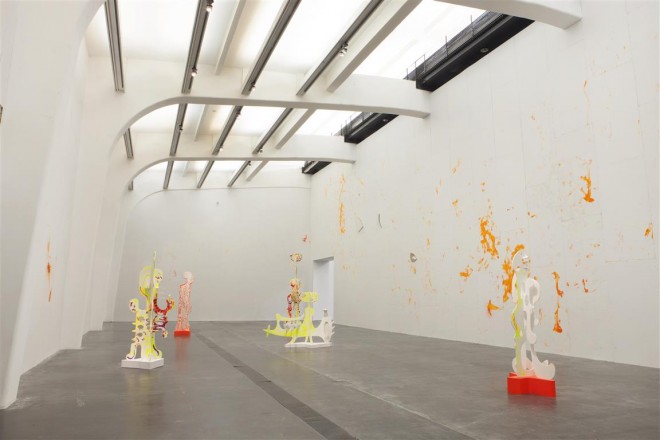
“The Los Angeles Project”, installation view, Aaron Curry, UCCA. Photo: Yang Chao Photo Studio. Courtesy of UCCA
《洛杉矶计划》展览现场,阿龙·柯里, 尤伦斯艺术中心。摄影:Yang Chao Photo Studio 照片由尤伦斯艺术中心提供
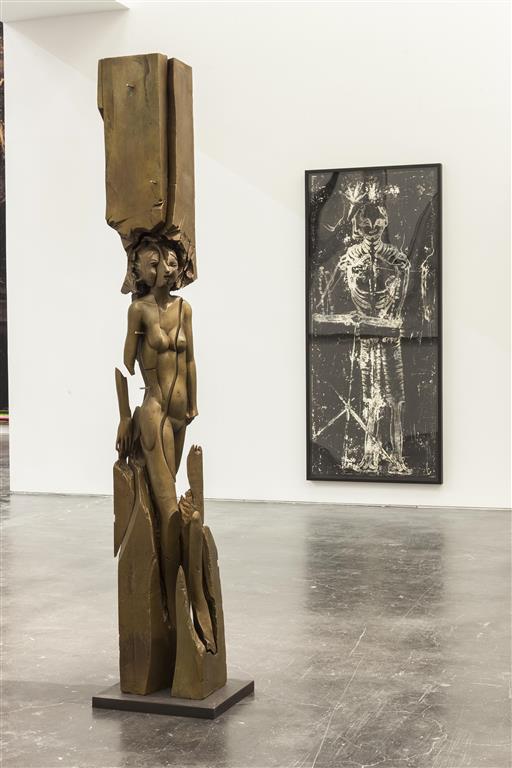
“The Los Angeles Project”, installation view, Matthew Monohan, UCCA. Photo: Yang Chao Photo Studio. Courtesy of UCCA
《洛杉矶计划》展览现场,马修·莫纳汉, 尤伦斯艺术中心。摄影:Yang Chao Photo Studio 照片由尤伦斯艺术中心提供
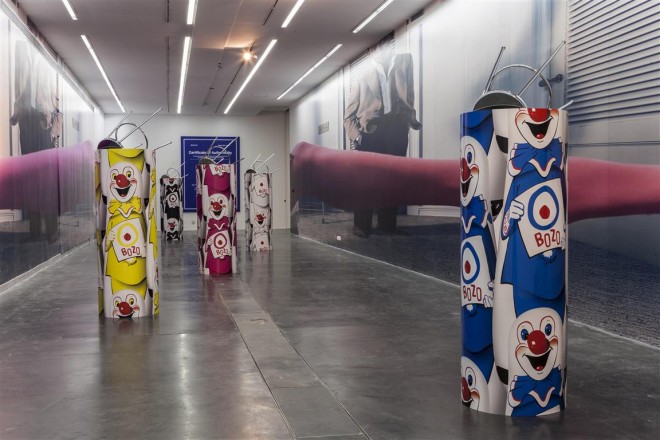
“The Los Angeles Project”, installation view, Kathryn Andrews, UCCA. Photo: Yang Chao Photo Studio. Courtesy of UCCA
《洛杉矶计划》展览现场,凯瑟琳·安德鲁斯, 尤伦斯艺术中心。摄影:Yang Chao Photo Studio 照片由尤伦斯艺术中心提供
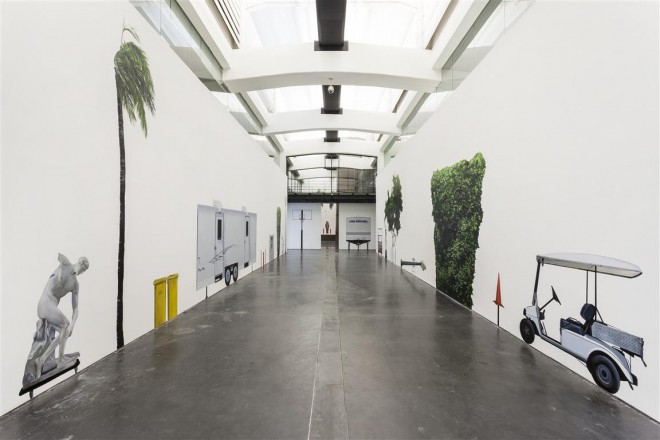
“The Los Angeles Project”, installation view, Alex Israel, UCCA. Photo: Yang Chao Photo Studio. Courtesy of UCCA
《洛杉矶计划》展览现场,亚历克斯·以色列, 尤伦斯艺术中心。摄影:Yang Chao Photo Studio 照片由尤伦斯艺术中心提供

“The Los Angeles Project”, installation view, Sterling Ruby, UCCA. Photo: Yang Chao Photo Studio. Courtesy of UCCA
《洛杉矶计划》展览现场,斯特林·鲁比, 尤伦斯艺术中心。摄影:Yang Chao Photo Studio 照片由尤伦斯艺术中心提供

